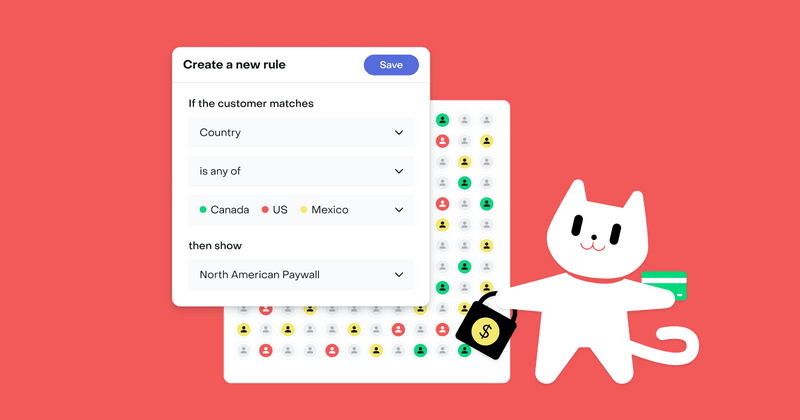Introducing Targeting: Customize your Offerings for every audience
Maximize subscription revenue with tailored paywall and pricing strategies for distinct audiences.


Dan Pannasch
One of the keys to maximizing your subscription revenue is understanding and catering to diverse user needs, preferences, and behaviors. There is no one-size-fits-all approach to monetizing your app.
This is why we’re excited to unveil Targeting — a new feature designed to finely tune your app’s pricing, packaging, and paywalls for specific audience groups.
Built on the foundation of our existing Offering model, Targeting introduces an added layer of flexibility and precision. With its user-friendly setup in the RevenueCat dashboard and customizable filters, Targeting enables a more tailored and strategic approach to app monetization, aligning your Offerings more closely with the unique segments of your user base.
This early release of Targeting allows you to define audiences by country, app version, app platform and RevenueCat SDK version. We’re continuing to expand this feature to allow for even more customized offering strategies in the near future.
How Targeting works
Targeting is designed to provide you with enhanced control over how you present your app’s paywalls and products. It’s built on the foundation of our existing model but introduces a new layer of flexibility and precision.
The foundation: Offerings
At the heart of RevenueCat are Offerings, which define the products and pricing that users see on their paywall. If you’re utilizing RevenueCat Paywalls, this model even includes the actual paywall UI.
In practice, when it comes time to serving your paywall, your app communicates with RevenueCat’s backend and requests the current Offering for a given customer. The paywall is then displayed in your app, either by using the RevenueCat paywall contained in the Offering or by rendering your custom paywall based on the products inside the Offering.
Customizing your app’s paywall used to stop at adjusting the current Offering in the RevenueCat dashboard. Now, Targeting adds a new dimension of customization to this process:
Defining user-specific rules: Targeting in RevenueCat allows you to create custom rules that determine what Offerings are shown to which users. This feature gives you the ability to craft rules based on specific user attributes: country, app version, app platform, and RevenueCat SDK version.
Implementing targeting rules: Setting up these rules is straightforward in the RevenueCat dashboard. For example, you can design a rule where users in Brazil are shown Offering A while the rest of your target markets see Offering B. Each rule is a combination of user conditions and a corresponding Offering, tailored to address diverse user needs and preferences effectively.
Flexibility and control: Rules can be activated or deactivated, allowing you to test and refine your strategies before they impact your users. The order of these rules is crucial as they are applied sequentially — the system checks each rule in turn and applies the first one that matches a user’s attributes.
Fallback to default Offering: If a user doesn’t meet any specific conditions, they revert to seeing your default Offering, ensuring a seamless experience for all users.
Example use cases for Targeting
Targeting unlocks a diverse array of strategies to enhance your app monetization. To illustrate the potential, here are a few high-level examples:
Localized strategies
Targeting lets you tailor Offerings for various countries, helping you to align with local purchasing power, cultural tastes, and market trends. This includes customized trial offers, effective paywall designs for different regions, and strategic price changes. For example, you could highlight unique feature-sets that resonate with regional habits.
Platform-specific Offerings
Tailor your Offerings to meet the unique behaviors and preferences of iOS and Android users. Android users, often more sensitive to price, might appreciate extended introductory offers or combined deals. But you could offer iOS users a range of higher-value packages, like lifetime plans, recognizing their willingness for long-term commitments.
Customizing based on app version
There are unique opportunities to customize Offerings as you release new features and app versions. For new versions, offer exclusive trials highlighting the latest features. For older versions, provide tailored Offerings to ensure backward compatibility. This approach guarantees that all users, regardless of their app version, can find value from your app.
To guide you and help you make the most of Targeting, we have published a blog packed with specific use case examples.
Getting started with Targeting
For more detail, explore our Targeting docs. We can’t wait to see how you use this new feature!
As we continue to improve and expand upon the early release of this feature, we’d value your feedback. Let us know your thoughts by filling in this brief survey.
In-App Subscriptions Made Easy
See why thousands of the world's tops apps use RevenueCat to power in-app purchases, analyze subscription data, and grow revenue on iOS, Android, and the web.



